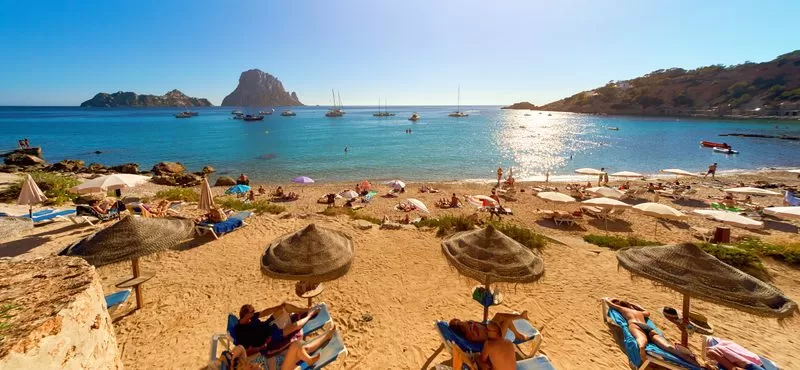Ibiza, Barcelona, and the Canary Islands are among the most sought-after Spanish destinations between June and November. This time of year offers the opportunity to enjoy the warmer weather, the beautiful beaches, and outdoor activities in Europe. If you’re planning a trip to Spain this summer, here are five important tips before you embark on your journey!
What is the Summer Weather Like in Spain?
Spain enjoys a mild climate year-round, predominantly Mediterranean, with about 3,000 hours of sunshine annually. However, the country experiences the contrasts of all four seasons.
Summer is the hottest season of the year. July and August are the warmest months, with hot and dry days throughout the country. Rainfall is minimal during the summer months.
During this time, temperatures often exceed 30°C during the day. In the interior and southern regions, nighttime temperatures can also be high, averaging above 20°C.
The northern part of the country, such as Galicia, has milder weather with lower temperatures and occasional rainfall.
How to Dress for Summer Travel in Spain?
Swimwear (bikinis, swimsuits, beach cover-ups) is essential for enjoying Spain in the summer. Light-colored, breathable fabrics are recommended for this season.
Be sure to pack cotton T-shirts, linen shorts and bermudas, loose-knit dresses, and other neutral-colored clothing that can be mixed and matched during your trip.
Despite the warm temperatures, it’s advisable to bring light jackets and scarves in case the temperature drops at night.
For footwear, bring flip-flops, flat sandals, and comfortable sneakers for walking around tourist sites without hurting your feet.
Tip: Don’t forget to pack a hat, cap, sunglasses, and sunscreen to make the most of sunny days in Spain!
Check out our article with tips on how to pack your suitcase for travel.
What Time Does It Get Dark in Spain During Summer?
In the summer, the sun generally sets around 9:30 PM or 10 PM, depending on the Spanish city.
According to World Data, which shows sunrise and sunset times, Las Palmas de Gran Canaria is where the sun sets the earliest, around 9 PM. In Vigo, daylight lasts until a little after 10 PM.
With longer days in the Spanish summer, both residents and tourists can enjoy the beaches and tourist sites for extended periods.
How to Make the Most of Summer in Spain?
To make the most of the European summer, wake up early, wear appropriate clothing for your activities, and plan your itinerary for each day. There are plenty of options! Here are some suggestions:
Enjoy Spanish Beaches
Some of the world’s best beaches are in Spain, with nearly 8,000 kilometers of coastline. Some must-visit spots include:
- Visiting the lighthouses in Galicia;
- Enjoying the vibrant beaches of Ibiza and Barcelona;
- Diving in Costa Brava;
- Exploring the turquoise waters of the Balearic Islands;
- Watching the sunset in bays like San Sebastián;
- Spending the day on Costa del Sol;
- Visiting the volcanic beaches of the Canary Islands.
Boat tours in cities like Barcelona and Menorca are also worth considering.
Explore Mountain Tourism
Mountain tourism is a great way to enjoy the warmer days. Notable spots include the peaks of the Picos de Europa in northern Spain and the Gállego River (Aragon) for adventure tourism enthusiasts.
Attend Outdoor Festivals
Summer is ideal for enjoying outdoor festivals such as “The Nights of the Botanic Garden” in Madrid and the popular parties in Ibiza.
Visit Parks
Longer days in Spain during summer mean that zoos and aquariums, like Zoo Aquarium in Madrid and Oceanogràfic in Valencia, extend their hours, allowing visitors to see animals at night.
Theme parks like Siam Park in Adeje, Tenerife, Parque Warner Madrid, and Isla Mágica in Seville also extend their hours.
Additionally, visit the main tourist attractions in your destination city, especially outdoor sites, as they are more accessible without rain. Don’t miss out on savoring Spanish cuisine, such as paella, tapas, tortilla de patata, and other dishes served at local restaurants.
How to Travel Safely to Spain in the Summer?
Travel insurance is mandatory for all visitors to Spain who do not hold European citizenship. Without it, your entry at immigration could be denied.
The coverage must include at least €30,000 for medical and hospital expenses. It’s recommended to get travel insurance tailored to your needs.
Even if you have European citizenship and are not required to have travel insurance, it is highly recommended. It offers protection against various unforeseen events, including medical, hospital, and dental expenses at private clinics or hospitals, lost luggage, pharmacy expenses, and more.
Skaii Seguros is Yellowling’s recommended provider for quick, reliable, and economical travel insurance. Their plans, offered by renowned and globally recognized insurers, provide comprehensive coverage to ensure you travel safely.
Now that you’ve read these important tips about summer in Spain, pack your bags and have a great trip!

